Applied Evolutionary Design
Chapter 1 - The Story
- Almost all the successful microservice stories have started with a monolith that got too big and was broken up
Almost all the cases where I've heard of a system that was built as a microservice system from scratch, it has ended up in serious trouble.
– Monolith First by Martin Fowler
These are what Martin heard from teams, however, the whole article didn't explain how to evolve from a monolith to microservices.
Those are all fair points of issues from the article, I don't think I can explain better than Martin.
But I probably was in one of the teams that told the story, maybe I could try explaining how exactly does that work?
Drowsy Cafe
Let us start from a story:
As a sleepy guy, I need to buy a cup of coffee from cafe
It sounds like a simple story, but that is too high level and not doable, let us break into 3 stories:
1. As a sleepy guy, I should able to order a latte from Drowsy Cafe
2. As a sleepy guy, I should able to pay for the latte with my master credit card
3. As a sleepy guy, I should able to get my latte 2 mins after the credit card transaction is done.
That is a lot better.
It is not very hard to identify that we have 3 actors here:
- the sleepy guy
- Drowsy Cafe
- the bank
Somehow they are all connected because of our story. So if we model these actors as relational database table, it would be something like:
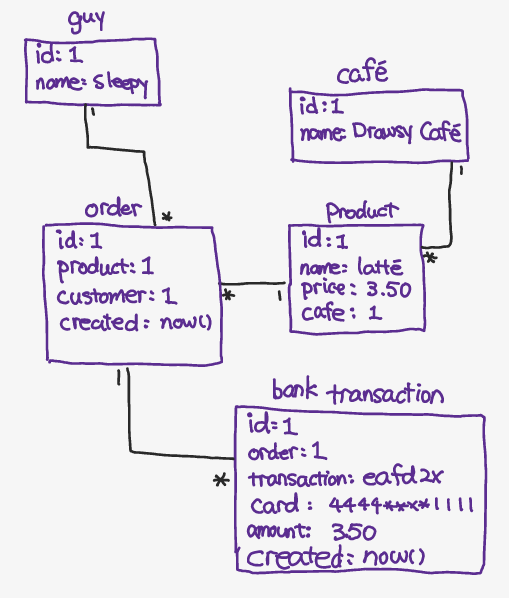
- Guy has many Orders
- Cafe has many Products
- Products has many Orders
- Orders has many transactions(when card rejected, user should able to retry)
BDD of Journey of the Guy
Given Cafe Drowsy Cafe has product Latte
And Transaction for any Order will success
When Guy sleepy order one product Latte
Then an Order will be generated
When Guy sleepy swipe an credit card on pos terminal
Then Guy receives his product Latte
The following is what the implementation will looks like in Scala. I've tried in amm, the code really compiles.
trait DrawsyCafeService {
type ProductId = Int
type OrderId = Int
type UserId = Int
type CreditCard = Int
object TransactionStatus extends Enumeration {
type Type = Value
val Success, Failed = Value
}
case class Transaction(
id: Int,
status: TransactionStatus.Type
)
case class Product(
id: Int,
name: String
)
def order(customer: UserId, product: ProductId): IO[OrderId]
def pay(order: OrderId, creditCard: CreditCard): IO[Transaction]
def brew(product: ProductId): IO[Product]
def canIHaveALatte(user: UserId, card: CreditCard): IO[Product] = for {
orderId <- order(customer = user, product = 1)
transaction <- pay(orderId, creditCard = card)
coffee <- if (transaction.status == TransactionStatus.Success)
brew(product = 1) else IO.raiseError(new Exception("payment failed please retry"))
} yield coffee
}
Seems very straight forward, just few line of code, we should start with:
- one Database that has the schema
- one Service that can place order and process payment
- one deployment pipeline to deploy the service
Which sounds like a Monolith, but not likely, since it is still very small, very easy to reason about and contribute features.
This implementation works great even some error happened.
Given Cafe Drowsy Cafe has product Latte
And Transaction for any Order will FAIL
When Guy sleepy order one product Latte
Then an Order will be generated
When Guy Sleepy swipe an credit card on pos terminal
Then Guy Sleepy won't get his product Latte
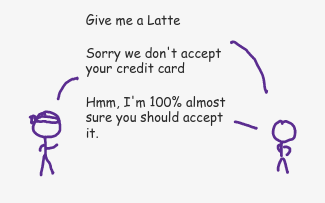
It is great, no transaction is success, the guy get nothing and safe to retry from the beginning.
Given Cafe Drowsy Cafe has product Latte
When Guy Sleepy order one product Latte
Then an Order is NOT generated
Then Guy Sleepy can NOT swipe credit card
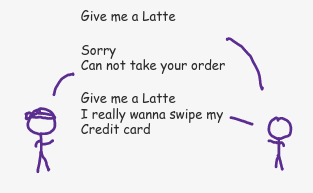
No problem, no order is generated, the guy can not even pay and safely retry from the beginning.
When all these story is done, Drowsy Cafe can open their service to the market.
1. As a sleepy guy, I should able to order a latte from /Drowsy Cafe/
2. As a sleepy guy, I should able to pay for the latte with my master credit card
3. As a sleepy guy, I should able to get my latte 2 mins after the credit card transaction is done.
It is not perfect service since:
- the sleepy guy has to retry if anything wrong happen even to cafe or bank
- only one barista working both on baking coffee and taking order, only can
serve one customer at a time.
- only sell Latte
- one customer can only order one coffee, they have to swipe credit card twice
if order two cups of coffee.
Overall experience ain't perfect, but at least Drowsy Cafe start selling coffee.
Drowsy Cafe 2.0
Drowsy Cafe is the only cafe that sells Latte at the whole street, so it become so popular that one barista can not serve all customer in 2 mins.
As business grow, service need to evolve as well, so they hire another one, now they can split the tasks of taking order and brewing coffee.
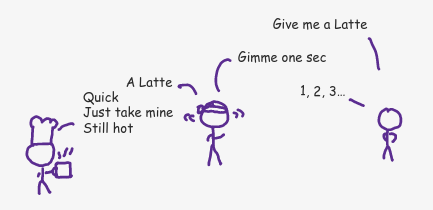
Now the Drowsy Cafe become something like microservices, it evolves into two services.
- A service just take care of taking order, process payment
- A Service just take care of brewing coffee
// This now become a remote call to another service
def brew(product: ProductId): IO[Product]
The investment of hiring another barista is soon paying back. Martin already summarized Microservice Trade-Offs
- Because barista only focus on one thing, now barista learn how to brew
espresso and flat white. So Drowsy Cafe now is selling 3 kinds of coffee.
- The other one just taking care of orders, they learn how to take multiple
coffee in single order, which keep the queue short and more customers are served.
It works great 99% of the time, and Drowsy Cafe gain 10x of profit comparing to previous version. But sometimes maybe there is network issue, or the barista is offline:
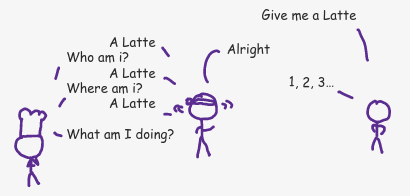
Such case lead to really troublesome situation, Drowsy Cafe already debit the money, but customer get nothing.
The customer rating is getting low and reputation is ruin. They're getting less and less customer because of the service availability is low.
Drowsy Cafe 2.0 isn't that success for long term, yes it has more features, but sacrificed availability.
What is the reason that causing all these issues? Martin already summarized Microservice Trade-Offs
How to Evolve to Microservices Properly
There are few things done wrong when we replacing current monolith with microservice.
Of cause we done something right as well – the services is split by domain context boundary.
- Order service focus on placing order and process payment, it does not need to have any context of how to brew a coffee.
- Brew service focus on brewing coffee, no need to have any context of how much the coffee cost or how to process the payment.
Domain context boundary is very clear, however, the way we split microservices is not appropriate.
Overall there are two kinds of pattern that your monolith can split with:
- Request Response Messaging: Message goes two way, request will get feedback of the result.
- One Way Messaging: Message only goes one way, the only success response is just ACK(nowledge), which does not indicate the process result.
Based on different business requirement, the best suitable pattern should be chose to achieve best result.
Like what Drowsy Cafe did to move brew function as remote service call, is using Request Response Message pattern.
When you call brew function, you can tell the coffee is ready or not by inspecting the response.
But the thing is, brew is more likely to fall into One Way Messaging pattern:
- Since the customer's credit card is charged, Cafe should grantee the a coffee must be made This is so call Eventually Consistency , otherwise a refund process should kick in.
- Brewing coffee is time consuming process, it make no sense to keep customer at the counter when coffee is brewing.
Next Chapter, we will go though the detail of how to apply One Way Messaging pattern, to save Drowsy Cafe 2.0 business.
Footnotes:
Martin already summarized Microservice Trade-Offs
This is so call Eventually Consistency